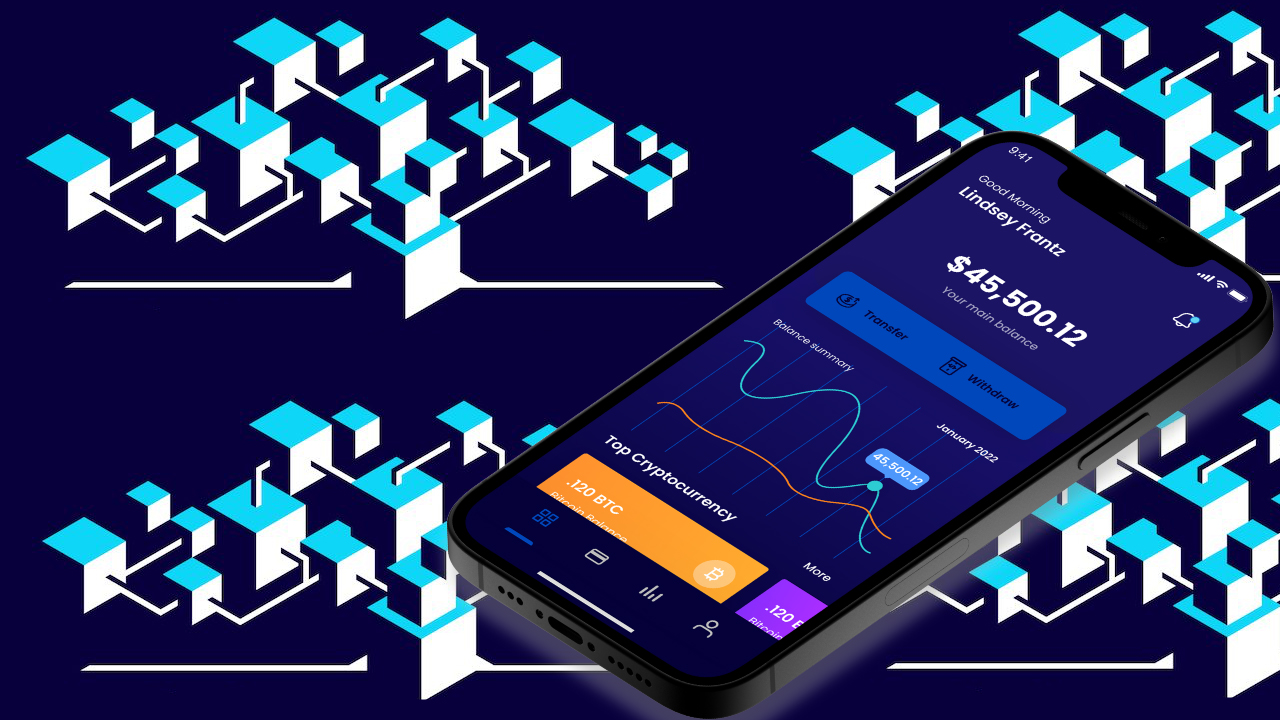 The crypto asset and exchange-traded fund (ETF) manager Wisdomtree has revealed the company is launching a new digital wallet called Wisdomtree Prime, which will allow users to hold crypto assets, blockchain-enabled funds, tokenized versions of commodities like gold, and access to stocks or bonds based on Wisdomtree’s indexes. Wisdomtree to Launch Prime Wallet in Q2, […]
The crypto asset and exchange-traded fund (ETF) manager Wisdomtree has revealed the company is launching a new digital wallet called Wisdomtree Prime, which will allow users to hold crypto assets, blockchain-enabled funds, tokenized versions of commodities like gold, and access to stocks or bonds based on Wisdomtree’s indexes. Wisdomtree to Launch Prime Wallet in Q2, […] SWIFT, the Belgian-based cooperative that serves as an intermediary and settlement executor of financial transactions between banks worldwide is planning to experiment with asset tokenization in 2022. In a blog post about the subject, SWIFT notes that it will be working with firms like Clearstream, Northern Trust, and SETL to explore “the feasibility and benefits” […]
SWIFT, the Belgian-based cooperative that serves as an intermediary and settlement executor of financial transactions between banks worldwide is planning to experiment with asset tokenization in 2022. In a blog post about the subject, SWIFT notes that it will be working with firms like Clearstream, Northern Trust, and SETL to explore “the feasibility and benefits” […]
The number of Bitcoin addresses holding less than 1 BTC has been rising in the face of a 30% price correction from $69,000.
Bitcoin (BTC) staged an impressive recovery after dropping to its three-month low of $42,333 on Dec. 4, rising to as high as $51,000 since.
The BTC price retracement primarily surfaced due to increased buying activity among addresses that hold less than 1 BTC. In contrast, the Bitcoin wallets with balances between 1,000 BTC and 10,000 BTC did little in supporting the upside move, data collected by Ecoinometrics showed.
"Bitcoin is still stuck in a situation where small addresses are willing to stack sats [the smallest unit account of Bitcoin], while the whale addresses aren't really accumulating," the crypto-focused newsletter noted after assessing the change in Bitcoin amounts across small and rich wallet groups, as shown in the graph below.

Ecoinometrics further asserted that the situation for Bitcoin is "not ideal," suggesting that the BTC price may end up resuming its decline in the absence of influential buyers.
Ecoinometrics' bearish outlook appeared as Bitcoin grappled with the Federal Reserve's policy decision on Wednesday to reduce its bond purchases by $30 billion every month to unwind them down by April next year entirely.
The $120 billion a month stimulus program was instrumental in sending the BTC price from below $4,000 in March 2020 to $69,000 in Nov 2021. And now that the liquidity threatens to go away, with lending to become costlier as the Fed prepares for three rate hikes next year, many fear that it would hurt investors' appetite for risk assets like Bitcoin.
Bitcoin price briefly popped above $49,000 after the Fed FOMC meeting confirmed at least three interest rate hikes and some adjustments to the current market supporting practices in 2022. https://t.co/TpTX7tGmYL pic.twitter.com/lXw47icZmB
— Cointelegraph Markets (@CointelegraphMT) December 15, 2021
Mike Novogratz, chief executive officer of Galaxy Digital Holdings, admitted that Bitcoin might feel "pain ahead" but anticipated that its price would not fall anywhere beyond the $42,000-support.
“$42,000 is at a pretty important level, and low 40s should hold,” the crypto billionaire told Bloomberg TV in an interview Tuesday, adding:
"So much money is pouring into the space, it would make no sense that the crypto prices would go much below that. If you’re long, it feels painful, but it’s probably healthy."

In reality, unique wallets holding more than or equal to 1,000 BTC have been declining all across 2021, with data from Glassnode showing its number dropping to 2,147 from 2,475 since Feb. 9.

In contrast, the number of unique wallets holding at least 0.01 BTC (around $485 at current exchange rates) rose in 2021, from 8.46 million to 9.39 million year-to-date.
Meanwhile, addresses holding at least 0.1 BTC (~$4,855) surged from 3.12 million to 3.30 million in the same period, indicating that "fishes" played a key role in pumping the Bitcoin price from around $30,000 to as high as $69,000 this year.

One more piece of evidence showing that retail investors have been bullish on Bitcoin, came from addresses that hold at least 1 BTC.
Related: Analysts expect Bitcoin trend change after Fed lays out its 2022 roadmap
These wallets decreased in quantity in the first half of 2021 as the BTC market grappled with the China ban and other negative news, but started increasing the second half as El Salvador adopted Bitcoin as its legal tender.

The number of Bitcoin wallets with at least 1 BTC also kept rising during the BTC price correction from $69,000 to $42,333 in the November-December session, signaling accumulation. It reached a seven-month high on Wednesday just as Bitcoin underwent a rebound to $50,000 from its weekly low near $46,000.
On-chain analyst Willy Woo also spotted retail accumulation rising to levels seen after the March 2020 crash, which led to Bitcoin's two-year-long bull run.

Additionally, Bitcoin's momentum indicator that preceeded its price breakout to $69,000 earlier this year is also hinting at a potential BTC price breakout ahead.
The views and opinions expressed here are solely those of the author and do not necessarily reflect the views of Cointelegraph.com. Every investment and trading move involves risk, you should conduct your own research when making a decision.

The only glitch in the bullish setup, for now, remains the Federal Reserve’s taper acceleration plans.
Cardano (ADA) may rally by nearly 30% in the coming days as it forms a classic bullish reversal pattern.
Dubbed “triple bottom,” the pattern typically occurs at the end of a downtrend and consists of three consecutive lows printed roughly atop the same level. This means triple bottoms indicate sellers’ inability to break below a specific support level on three back-to-back attempts, which ultimately paves the way for buyers to take over.
In a perfect scenario, the return of buyers to the market allows the instrument to retrace sharply toward a higher level, called the “neckline,” that connects the highs of the previous two rebounds. The move follows up with another breakout, this time taking the price higher by as much as the distance between the pattern’s bottom and neckline.
So far, ADA’s price has been able to paint the triple bottom halfway, now rebounding after forming the third low, as shown in the chart below.

The point at which ADA’s price reversed was accompanied by a rise in trading volume, suggesting that the rebound had enough backing from buyers. Therefore, Cardano’s token looks poised to at least pursue a run-up toward $1.40.
Moreover, if the price further breaks above the neckline level decisively, it will likely continue to rally until it hits $1.63 — as per the triple bottom scenario.
The potential triple bottom scenario emerged after ADA’s price plunged by more than 60% from its record high of $3.16 achieved on Sept. 2 earlier this year. It also surfaced as the Cardano token became one of the worst performers quarter-to-date, dropping nearly 45.50% compared to its top rival Ether’s (ETH) 15% gains.
ADA’s multi-month selloff pushed its daily relative strength index (RSI), a momentum indicator, into oversold territory. In addition, ADA’s price drop also led it to what appears like a dependable “accumulation area,” as shown in the chart below.

Both RSI and the accumulation area also point to a buying scenario in the ADA market, thus supporting the triple bottom scenario on the four-hour chart.
It is important to notice that ADA dropped by more than 5.50% in the past 24 hours, much in sync with other top crypto assets in the space, with Bitcoin (BTC) sinking by over 3% and Ether by almost 5% in the same period.
At the core of the crypto market’s uniformed decline was the United States Federal Reserve’s two-day policy meeting starting Tuesday. In the meetup, the U.S. central bank will likely decide to accelerate the tapering of its $120-billion-a-month asset-purchasing program, one of the key catalysts behind the crypto and stock market rally since March 2020.
Other parts of the Fed meeting will see the officials discussing the prospects of rate increases next year from its current near-zero levels. Cheaper lending had also played an important role in pushing the Bitcoin and altcoin market prices higher across 2020 and 2021, including ADA.
Related: Bitcoin price dip may end Wednesday as Bitfinex bids hint at Fed ‘buy the news’ plans
As Fed officials initiate their policy meeting, ADA is testing $1.18 as its weekly support for a potential price rebound. The $1.18 level is the 0.618 Fib line of what appears to be an accurate Fibonacci retracement graph in predicting ADA’s support and resistance levels.

Should ADA fail to rebound and close below $1.18, its next Fib support may come at the 0.786 Fib line near $0.674, around 42% below. Nonetheless, ADA/USD may also test $1 as psychological support for an early upside retracement, similar to its multiple rebounds between February and July 2021.
The views and opinions expressed here are solely those of the author and do not necessarily reflect the views of Cointelegraph.com. Every investment and trading move involves risk, you should conduct your own research when making a decision.
 As a growing number of governments are looking to tap into crypto profits, authorities in Austria have indicated their intention to tax gains from digital asset investments just like those from stocks and bonds. The move is expected to increase trust and access to cryptocurrencies. Austria to Apply Capital Gains Tax to Bitcoin, Make Crypto […]
As a growing number of governments are looking to tap into crypto profits, authorities in Austria have indicated their intention to tax gains from digital asset investments just like those from stocks and bonds. The move is expected to increase trust and access to cryptocurrencies. Austria to Apply Capital Gains Tax to Bitcoin, Make Crypto […] In mid-September China’s Evergrande Group, the country’s second-largest property developer by sales, sparked fear in the global economy as the company’s market valuation plummeted to an 11-year low. Global economists have warned that if Evergrande defaults on its debts, it could start a credit contagion similar to the Lehman Brothers bankruptcy in 2007. So far, […]
In mid-September China’s Evergrande Group, the country’s second-largest property developer by sales, sparked fear in the global economy as the company’s market valuation plummeted to an 11-year low. Global economists have warned that if Evergrande defaults on its debts, it could start a credit contagion similar to the Lehman Brothers bankruptcy in 2007. So far, […]
Led by Belgian financial services firm Euroclear, the latest French CBDC trial involved a system by tech giant IBM.
The central bank of France continues actively exploring a central bank digital currency (CBDC), completing a significant trial of a blockchain-based CBDC in the country’s debt market.
Over 500 institutions in France have participated in a 10-month experiment testing a CBDC issued by Banque de France for government bond deals, The Financial Times reported Oct. 19.
The CBDC trial was led by Belgium-based financial services firm Euroclear and used a system developed by American technology giant IBM. The CBDC test also involved the French public debt office alongside the central bank and a consortium of major financial companies operating in France, including firms like BNP Paribas, Crédit Agricole CIB, HSBC and Société Générale.
As part of the trial, the participants traded government bonds and security tokens, settling them using a CBDC supplied by the central bank. The project tested use cases of a CBDC in a range of everyday activities, such as issuing new bonds, using them in repurchase agreements, as well as paying coupons and redeeming deals.
“We have together successfully been able to measure the inherent benefits of this technology, concluding that the central bank digital currencies can settle central bank money safely and securely,” Euroclear executive Isabelle Delorme said.
According to Soren Mortensen, global director of financial markets at IBM, the project “went well beyond previous blockchain initiatives” because it successfully trialed “most central securities depository and central bank processes” while cutting off existing interim steps like reconciliation between market intermediaries.
Related: G7 leaders issue central bank digital currency guidelines
After launching an experimental CBDC program in March 2020, the central bank of France has been consistently testing various CBDC use cases. In June, Banque de France tested a CBDC to simulate the settlement and delivery of listed securities in collaboration with Swiss cryptocurrency bank SEBA. Previously, the central bank piloted a CBDC to issue $2.4 million worth of simulated shares using a private blockchain platform.
 On October 15, the day bitcoin’s price surpassed the $60K per unit handle, Salvadoran president Nayib Bukele taunted the professor of applied economics at Johns Hopkins University, Steve Hanke, over his recent statements. At the time, the well known economist warned that El Salvador faces “financial ruin” with “Bukele at the helm,” after El Salvador’s […]
On October 15, the day bitcoin’s price surpassed the $60K per unit handle, Salvadoran president Nayib Bukele taunted the professor of applied economics at Johns Hopkins University, Steve Hanke, over his recent statements. At the time, the well known economist warned that El Salvador faces “financial ruin” with “Bukele at the helm,” after El Salvador’s […]
Bitcoin price is down but crypto investors still have a plethora of yield opportunities thanks to DeFi.
The growth of the decentralized finance (DeFi) sector has been a recurrent headline throughout 2021 and to date, hundreds of billions of dollars in crypto assets are locked on protocols across numerous blockchain networks and earning a yield for their holders.
What started off as a simple Ethereum-based swap interface that allowed ERC-20 tokens to be exchanged in a decentralized manner, called Uniswap, has exploded into a vast ecosystem full of decentralized exchanges, yield farms, lending protocols and staking platforms.
As development continues and older protocols become more established, newer projects have emerged to incorporate more pieces from the traditional financial realm into the DeFi arena as digital technology slowly transforms the global financial system.
Here’s a look at some ways for users to get involved with DeFi outside of simply staking in liquidity pools or depositing to a lending protocol.
Cryptocurrency derivatives exchanges have long been a target for regulators, and once defiant exchanges like BitMEX and Binance have found themselves bending to the will of the law and modifying their operating practices as they seek a more legitimate standing.
This has furthered the necessity for crypto traders to have a decentralized option and led to the creation of protocols like dYdX and Hegic, which offer similar services without the target that is a centralized structure for regulators to come after.
DYdX is a non-custodial perpetuals trading platform built on a layer-two protocol that operates on the Ethereum network and offers users access to up to ten times leverage on futures contracts for more than twenty cryptocurrencies.
Hegic is an on-chain options trading protocol that utilizes hedge contracts and liquidity pools to offer options contracts that last up to 90 days and can payout in Ether (ETH), Wrapped Bitcoin (WBTC) or USD Coin (USDC).
The maximum period of holding options on Hegic has been lowered from 90 to 30 days . All previously acquired options are not affected by this change.
— Hegic (@HegicOptions) September 8, 2021
The max. period will be adjusted based on the current volatility in order to protect active LPs from selling vol too cheap. pic.twitter.com/JiVBVH5xD2
Both of these platforms offer users access to these advanced trading products without the need to divulge their identities, as is required on the centralized counterparts.
One topic that is increasingly popping up more in financial discussions is the concept of how to create a decentralized reserve currency that is free of the control of any government or centralized financial institution.
Olympus aims to address this issue through a decentralized autonomous organization (DAO) platform which offers staking and various bond offerings including the ability to bond Ether, MakerDAO (DAI), Liquidity USD (LUSD) and Frax (FRAX).
We just launched our third reserve bond, $LUSD! Welcome @LiquityProtocol to the Olympus Treasury. pic.twitter.com/34IKpTFG5l
— OlympusDAO (@OlympusDAO) September 22, 2021
The bonding process on Olympus is basically a cross between a fixed income product, a futures contract and an option. Bonders are provided with a quote outlining terms for a trade at a future date and include a predetermined amount of the protocol’s native OHM token that the bonder will receive once the vesting period is complete.
Funds that are raised by bond offerings go into the Olympus treasury as collateral to back the OHM tokens that were minted, helping to provide the underlying value behind the OHM token which allows it to be used as a reserve currency or medium of exchange.
The only other projects that have a treasury that provides the underlying value for each token are stablecoins, but as the name implies their price is fixed whereas the price of OHM can increase, offering a new avenue of yield for users.
Once bonding is complete, users can sell their OHM on the open market or stake them on the Olympus protocol for a current yield of 7,299%.
Related: CFTC renewed: What Biden’s new agency picks hold for crypto regulation
Another way crypto holders can put their assets to work while also helping the cryptocurrency ecosystem expand is through participating in the parachain auctions in the Polkadot and Kusama ecosystems through a process known as a crowd loan.
In the auction process, different projects vie for one of the limited parachain slots that connect the project directly to the main Kusma or Polkadot network, facilitating the interconnection of all parachains in the ecosystem.
With crowdloans, users who hold the native KSM and DOT tokens can “contribute” them towards the pool that a project uses to secure a parachain slot, and they will have their tokens returned after a specified lock-up or bonding period that can last for up to one year.
Current #Kusama crowdloan stats:
— Fabs (@fabsbags) September 21, 2021
☛ ~995k $KSM contributed to 16 projects
☛ ~88% (~875k $KSM) contributed to the 5 leading projects which means ~175k $KSM in average so far.
☛ This 88% equals ~78% of KSM contributed to the first 5 parachains.
These auctions are a huge success!
In exchange for their contribution and inability to earn staking rewards for the period that the tokens are locked up, users receive a specified number of tokens for the new protocol which can then be used in the ecosystem or sold on the market.
This approach offers a less risky yield opportunity for token holders, as all principal contributions are locked in a smart contract and returned after the stipulated lock-up period. And by the nature of the parachain auction process, there have been well-developed projects with larger communities that have secured parachain slots, increasing the chance that their tokens will maintain or increase in value as long development for the protocols stays active.
Aside from the threat of regulation, the DeFi ecosystem is showing few signs of slowing its integration of the best parts of the traditional financial system and developing innovative protocols that level the playing field for retail investors.
The views and opinions expressed here are solely those of the author and do not necessarily reflect the views of Cointelegraph.com. Every investment and trading move involves risk, you should conduct your own research when making a decision.

As the overall cryptocurrency market moves through a turbulent week, one under-the-radar altcoin is defying the downtrend in a major way. Decentralized reserve currency protocol Olympus (OHM) has surged by 34% over the past seven days. A possible catalyst for the price jump is the recent announcement of a new product called Olympus Pro. While […]
The post This Under-the-Radar Altcoin Is Up 34% This Week Despite the Crypto Market Correction appeared first on The Daily Hodl.